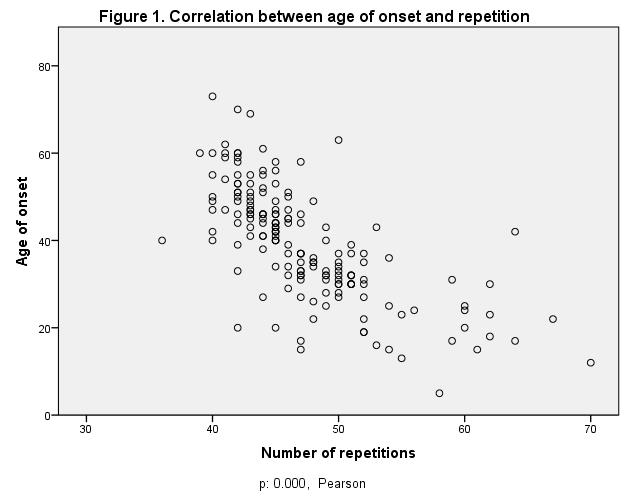Session Information
Date: Tuesday, June 6, 2017
Session Title: Huntington's Disease
Session Time: 1:45pm-3:15pm
Location: Exhibit Hall C
Objective: To describe the clinical features and CAG repeats in a large population of Mexican patients with Huntington’s disease and its relation to the age and type of onset.
Background: Huntington’s disease (HD) is an autosomal dominant progressive disease characterized by motor, psychiatric, and cognitive impairment. Its prevalence rate in Western countries is 5.7/100,000. The age of onset is between 45 years of age, however, there are the variants Juvenile (<20 years of age). The onset of motor symptoms is inversely correlated with the number of CAG repeats.
Methods: Data were collected from patients with genetic diagnosis of HD regularly attending in the National Institute of Neurology and Neurosurgery from February 2010 to November 2016. A standardized questionnaire was applied with clinical characteristics including: age and onset, affected family presenting, initial symptom and time of evolution. Statistical analysis was performed with X2, means, frequencies and Pearson.
Results: A total of 185 subjects were included (48.1% men). The mean age of onset of symptoms was 38.9±12.9 years. The inheritance predominance was maternal in 51% of the cases. A total of 167 patients had an onset after 20 years of age. Eighteen patients had an onset between 10-20 years of age. An association between a younger age of onset of symptoms and higher number of repeats was found (p<0.001). [Figure1]. Type of onset is showed in [Table 1].
Patients with HD onset ˃20 years, motor onset was present in 46.5%. Chorea was the predominant motor feature in 88% of the cases. Patients in the 10-20year group the onset was psychiatric in 65%, with depression being the most common. The mean of number of repeats in patients with onset ˃20 years was 46±5. On the other hand, mean CAG repeats in the ≤20years is 54±7. After 10-years follow-up, generalization of chorea occurred in approximately 50% of patients.
Conclusions: The age of onset of symptoms is lower than that reported in the literature. In addition, that the number of repeats is similar to other populations.
Patients with juvenile onset have more frequently a neuropsychiatric feature as an initial symptom. Conversely, patients with a more late onset have a motor symptom as first feature more commonly. Approximately 50% of patients who have focal chorea will have generalization within the first 10 years, which concludes that the disease has a greater progression in these early years.
References: Paul H. Gordon, Jason M. Mehal, Andrew S. Rowland, James E. Cheek, Michael L. Bartholomew. Huntington disease among the navajo: a population-based study in the Navajo nation. Neurology 86 April 19, 2016.
Miao Xu, Zhi‑Ying Wu. Huntington Disease in Asia. Chinese Medical Journal; July 5, 2015; Volume 128, Issue 13.
To cite this abstract in AMA style:
L. Mendoza Vega, M. Rodríguez-Violante, A. Cervantes-Arriaga, A. De-la-Cruz-Landero, N. Davila-Avila, K. Salinas-Barboza, S. Isais-Millan. Clinical and genetic characterization of Huntington’s disease in relation to the age and type of onset. [abstract]. Mov Disord. 2017; 32 (suppl 2). https://www.mdsabstracts.org/abstract/clinical-and-genetic-characterization-of-huntingtons-disease-in-relation-to-the-age-and-type-of-onset/. Accessed December 26, 2025.« Back to 2017 International Congress
MDS Abstracts - https://www.mdsabstracts.org/abstract/clinical-and-genetic-characterization-of-huntingtons-disease-in-relation-to-the-age-and-type-of-onset/


